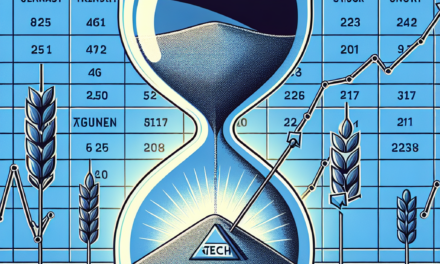“Strengthening the Greenback: Trump Trade Dynamics and Yield Trends Drive Dollar Surge”
Introduction
The interplay between trade dynamics under the Trump administration and evolving yield trends has significantly bolstered the strength of the U.S. dollar in global markets. During Trump’s tenure, a series of trade policies, including tariffs and renegotiated trade agreements, aimed to protect American industries and reduce trade deficits. These measures, coupled with the Federal Reserve’s monetary policy decisions, influenced yield trends, attracting foreign investment and increasing demand for the dollar. As a result, the dollar’s appreciation reflected both the economic strategies implemented domestically and the broader global financial environment, underscoring the complex relationship between trade policies, interest rates, and currency valuation.
Impact Of Trump Trade Policies On The Dollar’s Strength
The intricate relationship between trade policies and currency valuation has long been a subject of economic analysis, and the Trump administration’s trade policies have played a significant role in shaping the dynamics of the U.S. dollar. During Donald Trump’s presidency, a series of trade measures were implemented, which have had a profound impact on the strength of the dollar. These policies, characterized by a protectionist stance, aimed to reduce trade deficits and bolster domestic industries. As a result, they have influenced the dollar’s valuation in the global market, intertwining with yield trends to further bolster its strength.
To begin with, the imposition of tariffs on imports from major trading partners, such as China, was a cornerstone of Trump’s trade strategy. These tariffs were intended to protect American industries from foreign competition and encourage domestic production. However, they also led to retaliatory measures from affected countries, creating a complex web of trade tensions. In this environment, the dollar often emerged as a safe haven currency. Investors, wary of the uncertainties surrounding global trade, sought refuge in the dollar, thereby increasing its demand and, consequently, its value.
Moreover, the Trump administration’s tax reforms, which included significant corporate tax cuts, played a crucial role in attracting foreign investment. These reforms made the U.S. a more attractive destination for capital, further strengthening the dollar. As foreign investors sought to capitalize on the favorable tax environment, the influx of capital into the U.S. economy contributed to the appreciation of the dollar. This appreciation was further supported by the Federal Reserve’s monetary policy during this period, which saw gradual interest rate hikes. Higher interest rates typically attract foreign capital, as investors seek higher returns, thereby boosting the dollar’s strength.
In addition to trade policies and tax reforms, yield trends have also been instrumental in bolstering the dollar. The yield on U.S. Treasury securities is a critical factor influencing the dollar’s value. During Trump’s presidency, the yield on these securities experienced fluctuations, driven by both domestic and international factors. As yields rose, the dollar became more attractive to investors seeking higher returns on their investments. This, in turn, increased demand for the dollar, contributing to its appreciation.
Furthermore, the interplay between trade policies and yield trends created a feedback loop that reinforced the dollar’s strength. As trade tensions heightened, global economic uncertainty increased, prompting investors to seek the relative safety of U.S. assets. This increased demand for U.S. Treasuries, driving up their yields and further enhancing the dollar’s appeal. Consequently, the dollar’s strength was not solely a result of domestic policies but also a reflection of global economic dynamics.
In conclusion, the Trump administration’s trade policies, characterized by protectionism and tax reforms, have had a significant impact on the dollar’s strength. These policies, coupled with yield trends, have created a favorable environment for the dollar’s appreciation. As investors navigated the complexities of global trade tensions and sought higher returns, the dollar emerged as a preferred currency, bolstered by both domestic and international factors. This intricate interplay underscores the multifaceted nature of currency valuation and highlights the enduring influence of trade policies on the global economic landscape.
Analyzing Yield Trends In The Context Of Trump’s Economic Strategies
The dynamics of international trade and yield trends have long been pivotal in shaping the strength of the U.S. dollar. In recent years, the economic strategies implemented during the Trump administration have played a significant role in influencing these factors. Understanding the interplay between these strategies and yield trends provides valuable insights into the bolstering of the dollar.
During the Trump administration, a series of trade policies were introduced with the aim of revitalizing American manufacturing and reducing trade deficits. These policies, often characterized by tariffs and renegotiated trade agreements, were designed to protect domestic industries and encourage foreign investment in the United States. As a result, these measures had a profound impact on the global trade landscape, leading to shifts in trade balances and influencing currency valuations.
One of the key outcomes of these trade policies was the strengthening of the U.S. dollar. As tariffs were imposed on imports, particularly from major trading partners like China, the cost of foreign goods increased. This, in turn, made American products more competitive both domestically and internationally. Consequently, there was a surge in demand for U.S. goods, which contributed to an appreciation of the dollar. Moreover, the renegotiation of trade agreements, such as the United States-Mexico-Canada Agreement (USMCA), further solidified the dollar’s position by fostering a more favorable trade environment for American businesses.
In parallel, yield trends have also played a crucial role in supporting the dollar’s strength. The relationship between interest rates and currency value is well-established, with higher yields typically attracting foreign investment and boosting demand for the currency. During the Trump administration, the Federal Reserve’s monetary policy was characterized by gradual interest rate hikes, reflecting a robust economic outlook. These rate increases made U.S. assets more attractive to investors seeking higher returns, thereby driving up demand for the dollar.
Furthermore, the interplay between trade dynamics and yield trends created a reinforcing cycle that bolstered the dollar. As trade policies led to a stronger dollar, the increased purchasing power of American consumers and businesses further stimulated economic growth. This growth, in turn, supported the Federal Reserve’s decision to maintain or raise interest rates, perpetuating the cycle of dollar appreciation.
However, it is important to consider the broader implications of these dynamics. While a strong dollar can benefit consumers by making imports cheaper and controlling inflation, it can also pose challenges for exporters by making U.S. goods more expensive abroad. Additionally, the reliance on tariffs and protectionist measures can lead to trade tensions and retaliatory actions from other countries, potentially disrupting global supply chains and economic stability.
In conclusion, the economic strategies implemented during the Trump administration, particularly in the realm of trade, have had a significant impact on yield trends and the strength of the U.S. dollar. By fostering a more competitive trade environment and supporting higher interest rates, these policies have contributed to the dollar’s appreciation. However, it is essential to balance these benefits with the potential challenges they pose to ensure sustainable economic growth. As the global economic landscape continues to evolve, understanding the intricate relationship between trade dynamics and yield trends remains crucial for policymakers and investors alike.
How Trade Dynamics Under Trump Influence Global Currency Markets
The intricate interplay between trade dynamics under the Trump administration and global currency markets has been a subject of considerable analysis and debate. During Donald Trump’s presidency, a series of trade policies and economic strategies were implemented that significantly influenced the global financial landscape, particularly affecting the strength and stability of the U.S. dollar. These policies, characterized by a protectionist stance, aimed to recalibrate trade relationships and address perceived imbalances, thereby impacting currency valuations worldwide.
One of the most notable aspects of Trump’s trade policy was the imposition of tariffs on imports from key trading partners, including China and the European Union. These tariffs were intended to protect domestic industries and reduce the trade deficit. However, they also led to retaliatory measures, creating a complex web of trade tensions. As a result, global markets experienced heightened volatility, with investors seeking safe-haven assets, notably the U.S. dollar. The dollar’s status as the world’s primary reserve currency meant that it often benefited from such uncertainty, as investors flocked to its relative safety amidst global economic turbulence.
Moreover, the Trump administration’s tax reforms, which included significant corporate tax cuts, played a crucial role in influencing currency markets. These reforms were designed to stimulate domestic investment and economic growth, leading to an influx of capital into the United States. Consequently, the demand for the dollar increased, further bolstering its value. This appreciation of the dollar had far-reaching implications, affecting not only trade balances but also the competitiveness of U.S. exports on the global stage.
In addition to trade policies and tax reforms, the Federal Reserve’s monetary policy during this period also contributed to the dynamics of the dollar. The Fed’s decisions on interest rates were closely watched by global investors, as higher rates typically attract foreign capital, thereby strengthening the dollar. Under Trump’s tenure, the Fed’s approach to interest rates was influenced by a combination of domestic economic indicators and external pressures, including trade tensions. The interplay between fiscal and monetary policies created a complex environment for currency markets, with the dollar often reflecting the broader economic narrative.
Furthermore, the geopolitical landscape during Trump’s presidency added another layer of complexity to currency dynamics. The administration’s approach to international relations, characterized by a focus on bilateral agreements and a departure from multilateral trade deals, reshaped global trade networks. This shift had implications for currency markets, as countries adjusted their economic strategies in response to changing trade patterns. The resulting uncertainty often led to fluctuations in currency values, with the dollar frequently emerging as a beneficiary due to its perceived stability.
In conclusion, the trade dynamics under the Trump administration had a profound impact on global currency markets, with the U.S. dollar experiencing significant fluctuations in response to various economic and geopolitical factors. The combination of protectionist trade policies, tax reforms, and monetary policy decisions created a complex environment that influenced investor behavior and currency valuations. As the world continues to navigate the evolving landscape of international trade and finance, understanding the legacy of these policies remains crucial for comprehending current and future trends in global currency markets. The intricate relationship between trade dynamics and currency strength underscores the interconnectedness of global economies and the pivotal role of the U.S. dollar in shaping financial stability worldwide.
The Role Of Yield Trends In Shaping The Dollar’s Trajectory

The intricate relationship between trade dynamics and yield trends plays a pivotal role in shaping the trajectory of the U.S. dollar. In recent years, the policies and economic strategies implemented during the Trump administration have had a significant impact on global trade, subsequently influencing the strength and stability of the dollar. As we delve into the nuances of this relationship, it becomes evident that yield trends are a crucial factor in understanding the dollar’s movements.
To begin with, the Trump administration’s trade policies, characterized by tariffs and renegotiations of trade agreements, have had a profound effect on international trade dynamics. These policies aimed to reduce trade deficits and bring manufacturing jobs back to the United States. However, they also introduced a level of uncertainty in global markets, prompting investors to seek safe-haven assets, such as the U.S. dollar. Consequently, the demand for the dollar increased, bolstering its value against other currencies.
Simultaneously, yield trends have played an essential role in shaping the dollar’s trajectory. The yield on U.S. Treasury securities is a critical indicator of investor sentiment and economic outlook. When yields rise, it often signals confidence in the U.S. economy, attracting foreign investment and increasing demand for the dollar. Conversely, declining yields may indicate economic uncertainty, leading to a weaker dollar. During the Trump era, tax cuts and increased government spending contributed to higher yields, further strengthening the dollar.
Moreover, the interplay between trade dynamics and yield trends is evident in the way they influence each other. For instance, trade tensions can lead to fluctuations in yields as investors adjust their expectations for economic growth and inflation. In turn, these yield changes impact the dollar’s value, creating a feedback loop that underscores the complexity of global financial markets. As trade policies evolve, so too do investor perceptions, which are reflected in yield movements and, ultimately, the dollar’s strength.
In addition to these factors, the Federal Reserve’s monetary policy decisions also play a crucial role in determining yield trends and, by extension, the dollar’s trajectory. During the Trump administration, the Fed’s approach to interest rates and quantitative easing was closely watched by investors. Changes in interest rates can lead to shifts in yields, influencing the attractiveness of the dollar as an investment. For example, rate hikes typically result in higher yields, drawing foreign capital and boosting the dollar’s value.
Furthermore, the global economic landscape cannot be overlooked when considering the dollar’s trajectory. The interconnectedness of economies means that developments in other regions, such as Europe or Asia, can have ripple effects on U.S. yield trends and the dollar. For instance, economic slowdowns or political uncertainties abroad may drive investors toward the relative safety of U.S. assets, increasing demand for the dollar and impacting its value.
In conclusion, the dynamics of trade policies and yield trends are intricately linked in shaping the trajectory of the U.S. dollar. The Trump administration’s trade strategies, coupled with yield fluctuations and Federal Reserve policies, have collectively influenced the dollar’s strength in recent years. As global economic conditions continue to evolve, understanding these relationships remains essential for investors and policymakers alike, as they navigate the complexities of international finance and currency markets.
Trump Administration’s Trade Tactics And Their Effect On The Dollar
The Trump administration’s trade tactics have played a pivotal role in shaping the dynamics of the U.S. dollar, particularly through their influence on trade policies and economic strategies. During President Donald Trump’s tenure, a series of aggressive trade measures were implemented, which significantly impacted global markets and, consequently, the value of the dollar. These measures included imposing tariffs on imports from major trading partners, renegotiating trade agreements, and prioritizing domestic manufacturing. As a result, the dollar experienced fluctuations that were closely tied to the administration’s trade policies.
One of the most notable aspects of Trump’s trade strategy was the imposition of tariffs on Chinese goods, which aimed to reduce the trade deficit and protect American industries. This move led to a trade war between the United States and China, creating uncertainty in global markets. As investors sought safe-haven assets amidst the volatility, the demand for the U.S. dollar increased, thereby strengthening its value. Moreover, the tariffs prompted shifts in global supply chains, compelling companies to reconsider their manufacturing and sourcing strategies. This realignment further influenced currency markets, as businesses adjusted to the new trade landscape.
In addition to tariffs, the Trump administration renegotiated key trade agreements, such as the North American Free Trade Agreement (NAFTA), which was replaced by the United States-Mexico-Canada Agreement (USMCA). These renegotiations were designed to secure more favorable terms for the United States, thereby boosting domestic economic growth. The anticipation and eventual implementation of these agreements contributed to the dollar’s strength, as they were perceived as enhancing the competitiveness of U.S. industries. Consequently, the dollar’s value was buoyed by the expectation of increased economic activity and improved trade balances.
Furthermore, the administration’s focus on tax reforms and deregulation also played a role in bolstering the dollar. By reducing corporate tax rates and easing regulatory burdens, the Trump administration aimed to stimulate economic growth and attract foreign investment. These policies were successful in creating a more favorable business environment, which in turn increased the demand for the dollar as investors sought to capitalize on the robust U.S. economy. The influx of foreign capital further supported the dollar’s appreciation, as it underscored confidence in the U.S. economic outlook.
However, it is important to note that the dollar’s strength was not solely attributed to trade policies. Yield trends also played a significant role in shaping the currency’s trajectory. During Trump’s presidency, the Federal Reserve embarked on a path of gradual interest rate hikes, which contributed to higher yields on U.S. Treasury securities. This made dollar-denominated assets more attractive to investors, thereby increasing demand for the currency. The interplay between trade dynamics and yield trends created a complex environment in which the dollar’s value was influenced by both domestic and international factors.
In conclusion, the Trump administration’s trade tactics, coupled with yield trends, significantly bolstered the U.S. dollar. Through a combination of tariffs, trade agreement renegotiations, tax reforms, and deregulation, the administration sought to enhance the competitiveness of American industries and stimulate economic growth. These efforts, alongside rising interest rates, contributed to the dollar’s strength by increasing demand for the currency in global markets. As a result, the dollar’s value was shaped by a confluence of trade policies and economic strategies, reflecting the intricate dynamics of the Trump era.
Exploring The Relationship Between Yield Trends And Dollar Valuation
The intricate relationship between yield trends and dollar valuation has long been a subject of interest for economists and investors alike. In recent years, the dynamics of trade policies under the Trump administration have further complicated this relationship, adding layers of complexity to the global financial landscape. As we explore the interplay between these factors, it becomes evident that the valuation of the dollar is influenced by a confluence of economic indicators, policy decisions, and market perceptions.
To begin with, yield trends, particularly those of U.S. Treasury bonds, play a pivotal role in determining the strength of the dollar. Higher yields often attract foreign investment, as investors seek better returns on their capital. This influx of foreign capital increases demand for the dollar, thereby bolstering its value. Conversely, when yields decline, the attractiveness of U.S. assets diminishes, potentially leading to a depreciation of the dollar. However, the relationship is not always straightforward, as other factors, such as inflation expectations and global risk sentiment, also come into play.
The Trump administration’s trade policies have added another layer of complexity to this dynamic. By imposing tariffs and renegotiating trade agreements, the administration aimed to reduce trade deficits and protect domestic industries. These measures, while intended to strengthen the U.S. economy, have had mixed effects on the dollar. On one hand, protectionist policies can lead to a stronger dollar by reducing the trade deficit and increasing demand for U.S. goods. On the other hand, they can also lead to retaliatory measures from trading partners, which may dampen global trade and economic growth, ultimately exerting downward pressure on the dollar.
Moreover, the uncertainty surrounding trade negotiations has often led to increased market volatility. In such times, the dollar tends to benefit from its status as a safe-haven currency. Investors, seeking refuge from market turbulence, flock to the relative safety of the dollar, thereby driving up its value. This phenomenon underscores the complex interplay between trade dynamics and yield trends, as both factors can simultaneously influence investor behavior and currency valuation.
In addition to these considerations, it is important to recognize the role of monetary policy in shaping yield trends and, by extension, dollar valuation. The Federal Reserve’s decisions regarding interest rates and quantitative easing have a direct impact on bond yields. For instance, an increase in interest rates typically leads to higher yields, attracting foreign investment and strengthening the dollar. Conversely, accommodative monetary policy, characterized by low interest rates and asset purchases, can lead to lower yields and a weaker dollar.
In conclusion, the relationship between yield trends and dollar valuation is multifaceted, influenced by a myriad of factors including trade policies, market sentiment, and monetary policy. The Trump administration’s trade dynamics have added further complexity to this relationship, highlighting the interconnectedness of global economic forces. As investors and policymakers navigate this intricate landscape, understanding the nuances of these interactions becomes increasingly crucial. By closely monitoring yield trends, trade developments, and monetary policy decisions, stakeholders can better anticipate shifts in dollar valuation and make informed decisions in an ever-evolving global economy.
The Interplay Between Trump’s Trade Policies And Yield Movements
The intricate relationship between trade policies and financial markets has always been a subject of keen interest for economists and investors alike. In recent years, the dynamics introduced by former President Donald Trump’s trade policies have had a profound impact on global markets, particularly influencing the strength of the U.S. dollar. As we delve into the interplay between these trade policies and yield movements, it becomes evident that the dollar’s resilience is closely tied to these economic strategies.
To begin with, Trump’s trade policies, characterized by a protectionist stance, aimed to reduce trade deficits and bring manufacturing jobs back to the United States. These policies included imposing tariffs on imports from major trading partners, notably China, which led to a series of retaliatory measures. The immediate effect of these tariffs was an increase in the cost of imported goods, which, in turn, affected consumer prices and corporate profit margins. However, the broader impact was felt in the currency markets, where the dollar began to strengthen as investors sought the relative safety of U.S. assets amidst global trade uncertainties.
Moreover, the trade tensions initiated by these policies created a ripple effect across global markets, leading to shifts in capital flows. Investors, wary of the potential for prolonged trade wars, began reallocating their portfolios towards U.S. assets, which were perceived as more stable. This influx of capital into the United States further bolstered the dollar, as demand for the currency increased. Consequently, the dollar’s appreciation was not merely a reflection of domestic economic strength but also a response to global economic realignments prompted by trade policy shifts.
In tandem with these trade dynamics, yield movements have played a crucial role in reinforcing the dollar’s position. The Federal Reserve’s monetary policy, particularly its interest rate decisions, has been a significant factor influencing yield trends. During Trump’s tenure, the Fed embarked on a path of gradual interest rate hikes, aimed at normalizing monetary policy following years of accommodative measures post-financial crisis. Higher interest rates typically attract foreign investment, as they offer better returns compared to other developed economies with lower rates. This, in turn, increases demand for the dollar, as investors need to purchase the currency to invest in U.S. assets.
Furthermore, the interplay between trade policies and yield movements is evident in the way market participants anticipate and react to policy announcements. For instance, expectations of further trade escalations or resolutions can lead to fluctuations in bond yields, as investors adjust their risk assessments. A resolution to trade disputes might lead to lower yields, as risk premiums decrease, while heightened tensions could push yields higher due to increased demand for safe-haven assets. These yield adjustments, in turn, influence the dollar’s trajectory, as they affect the relative attractiveness of U.S. investments.
In conclusion, the interplay between Trump’s trade policies and yield movements has been a defining factor in bolstering the U.S. dollar. The protectionist measures and ensuing global trade tensions have driven capital flows towards the United States, strengthening the dollar. Simultaneously, the Federal Reserve’s interest rate policies have complemented these dynamics by attracting foreign investment through higher yields. As we continue to navigate the complexities of global trade and monetary policy, understanding these interconnections remains crucial for anticipating future currency trends.
Q&A
1. **What is the main focus of the article “Trump Trade Dynamics and Yield Trends Bolster Dollar”?**
– The article focuses on how trade policies and yield trends during Trump’s administration have strengthened the U.S. dollar.
2. **How did Trump’s trade policies impact the U.S. dollar?**
– Trump’s trade policies, including tariffs and renegotiated trade deals, created market conditions that increased demand for the U.S. dollar.
3. **What role did yield trends play in bolstering the dollar?**
– Rising U.S. Treasury yields attracted foreign investment, increasing demand for the dollar as investors sought higher returns.
4. **Which sectors were most affected by the stronger dollar?**
– Export-driven sectors and multinational companies were most affected, as a stronger dollar made U.S. goods more expensive abroad.
5. **How did the stronger dollar impact global markets?**
– The stronger dollar led to capital outflows from emerging markets and increased the cost of dollar-denominated debt for foreign borrowers.
6. **What were the potential risks associated with a stronger dollar?**
– Risks included reduced competitiveness of U.S. exports, potential trade tensions, and financial strain on countries with significant dollar-denominated debt.
7. **Did the article mention any long-term implications of these dynamics?**
– Yes, the article discussed potential long-term implications such as shifts in global trade patterns and the possibility of sustained dollar strength affecting global economic stability.
Conclusion
The dynamics of trade policies under the Trump administration, coupled with rising yield trends, have significantly strengthened the U.S. dollar. The administration’s focus on renegotiating trade agreements and imposing tariffs aimed at protecting domestic industries has led to shifts in global trade patterns, often resulting in increased demand for the dollar. Concurrently, the Federal Reserve’s monetary policy, characterized by interest rate hikes in response to economic growth and inflationary pressures, has contributed to higher yields on U.S. Treasury securities. These higher yields have attracted foreign investment, further bolstering the dollar’s value. Overall, the interplay between trade dynamics and yield trends during this period has reinforced the dollar’s position as a dominant global currency, impacting international markets and economic relations.





